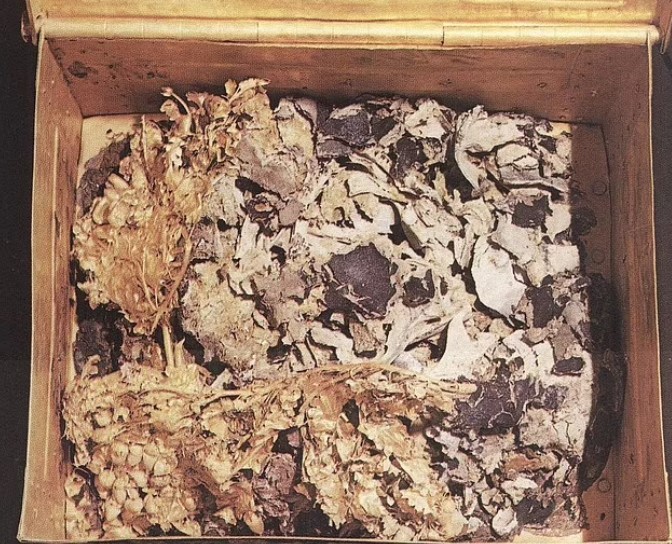Fabulous
Alexander the Great's lost TUNIC is found after 2,300 years
Alexander the Great's Lost Tunic Rediscovered in Vergina Tomb After 2,300 Years.

Archaeologists have uncovered what they believe is the ancient tunic of Alexander the Great in the royal tombs of Vergina, Greece. This striking purple-and-white garment, called the "mesoleucon sarapis," was found in fragments 47 years ago but only recently identified as belonging to the legendary king. Though not found in Alexander’s own tomb, which remains a mystery, the tunic was discovered among the treasures of his half-brother, Philip III of Macedon, suggesting it was an inherited item of profound significance.
This incredible finding offers a rare glimpse into the regalia of one of history's most celebrated military leaders. Alexander the Great ruled Macedon from 336 to 323 BC, leading campaigns that expanded the Greek empire to the borders of India. Known for his unmatched prowess in strategy and warfare, he amassed an empire that spanned most of the known world at the time, though he died at the young age of 32. His exact burial location remains unknown, adding intrigue to any artifact believed to be connected to him.
Discovery and Identification of the Tunic
The tunic fragments were found in 1977 at the Vergina tombs, one of Greece’s most significant archaeological sites. For years, they remained misunderstood and largely dismissed as either remnants of other clothing or even a ceremonial mask. However, recent research led by Professor Antonios Bartsiokas, a noted anthropologist at the Democritus University of Thrace, suggests these fabric pieces are consistent with historical descriptions of Alexander’s ceremonial tunic, renowned for its opulent purple hue and elaborate structure.
In his study, Bartsiokas explains that the tunic’s distinct characteristics align closely with ancient descriptions of the mesoleucon sarapis. This garment, reserved for elite rulers and pharaohs, was said to be “the most precious object in antiquity,” worn exclusively by royalty. The ancient sources describe the tunic as a white and purple piece with materials sourced from regions accessible only to the wealthiest individuals. Bartsiokas’ research involved chemical, microscopic, and physical analyses, which revealed a textile blend of purple-dyed cotton layered with a whitish mineral substance called huntite—a combination that highlights the garment’s luxurious craftsmanship.

“The physical description exactly fits the ancient sources on the Persian mesoleucon sarapis,” said Bartsiokas. “This is a garment that belonged to both Pharaoh and King Alexander the Great and carried immense symbolic and ceremonial importance.”
The Vergina Tombs and the Family of Alexander the Great
The tunic was located in “Tomb II,” one of three royal tombs unearthed at Vergina. Initial excavation work at Vergina began in the late 1970s, led by Greek archaeologist Manolis Andronikos, who discovered the complex believed to contain the remains of Macedonian royalty. These tombs, identified as I, II, and III, have sparked long-standing debates and mystery among historians, as each contains remarkable artifacts and skeletal remains.
Though Tomb II housed the tunic, the actual occupant was not Alexander himself but his half-brother, Philip III of Macedon. According to Bartsiokas, Philip III likely inherited the royal garments after Alexander’s death in Babylon in 323 BC. Alongside the tunic, other treasures discovered in Tomb II included a gold diadem, a golden oak wreath, and a scepter—items typically reserved for royalty, underscoring the tomb’s high-status occupant.
Tomb I is believed to contain the remains of Alexander’s father, Philip II, while Tomb III houses Alexander IV, Alexander the Great’s son. Bartsiokas has previously shed light on these burials, correcting a long-standing misidentification within the Vergina complex. His research established that the remains in Tomb I belonged to Philip II, not Philip III, as was previously assumed. He also identified the presence of Philip II’s young wife Cleopatra and their infant child, who were believed to have been assassinated shortly after Philip’s death.
Latest News
Alexander the Great's Lost Tunic Rediscovered in Vergina Tomb After 2,300 Years.

Archaeologists have uncovered what they believe is the ancient tunic of Alexander the Great in the royal tombs of Vergina, Greece. This striking purple-and-white garment, called the "mesoleucon sarapis," was found in fragments 47 years ago but only recently identified as belonging to the legendary king. Though not found in Alexander’s own tomb, which remains a mystery, the tunic was discovered among the treasures of his half-brother, Philip III of Macedon, suggesting it was an inherited item of profound significance.
This incredible finding offers a rare glimpse into the regalia of one of history's most celebrated military leaders. Alexander the Great ruled Macedon from 336 to 323 BC, leading campaigns that expanded the Greek empire to the borders of India. Known for his unmatched prowess in strategy and warfare, he amassed an empire that spanned most of the known world at the time, though he died at the young age of 32. His exact burial location remains unknown, adding intrigue to any artifact believed to be connected to him.
Discovery and Identification of the Tunic
The tunic fragments were found in 1977 at the Vergina tombs, one of Greece’s most significant archaeological sites. For years, they remained misunderstood and largely dismissed as either remnants of other clothing or even a ceremonial mask. However, recent research led by Professor Antonios Bartsiokas, a noted anthropologist at the Democritus University of Thrace, suggests these fabric pieces are consistent with historical descriptions of Alexander’s ceremonial tunic, renowned for its opulent purple hue and elaborate structure.
In his study, Bartsiokas explains that the tunic’s distinct characteristics align closely with ancient descriptions of the mesoleucon sarapis. This garment, reserved for elite rulers and pharaohs, was said to be “the most precious object in antiquity,” worn exclusively by royalty. The ancient sources describe the tunic as a white and purple piece with materials sourced from regions accessible only to the wealthiest individuals. Bartsiokas’ research involved chemical, microscopic, and physical analyses, which revealed a textile blend of purple-dyed cotton layered with a whitish mineral substance called huntite—a combination that highlights the garment’s luxurious craftsmanship.

“The physical description exactly fits the ancient sources on the Persian mesoleucon sarapis,” said Bartsiokas. “This is a garment that belonged to both Pharaoh and King Alexander the Great and carried immense symbolic and ceremonial importance.”
The Vergina Tombs and the Family of Alexander the Great
The tunic was located in “Tomb II,” one of three royal tombs unearthed at Vergina. Initial excavation work at Vergina began in the late 1970s, led by Greek archaeologist Manolis Andronikos, who discovered the complex believed to contain the remains of Macedonian royalty. These tombs, identified as I, II, and III, have sparked long-standing debates and mystery among historians, as each contains remarkable artifacts and skeletal remains.
Though Tomb II housed the tunic, the actual occupant was not Alexander himself but his half-brother, Philip III of Macedon. According to Bartsiokas, Philip III likely inherited the royal garments after Alexander’s death in Babylon in 323 BC. Alongside the tunic, other treasures discovered in Tomb II included a gold diadem, a golden oak wreath, and a scepter—items typically reserved for royalty, underscoring the tomb’s high-status occupant.
Tomb I is believed to contain the remains of Alexander’s father, Philip II, while Tomb III houses Alexander IV, Alexander the Great’s son. Bartsiokas has previously shed light on these burials, correcting a long-standing misidentification within the Vergina complex. His research established that the remains in Tomb I belonged to Philip II, not Philip III, as was previously assumed. He also identified the presence of Philip II’s young wife Cleopatra and their infant child, who were believed to have been assassinated shortly after Philip’s death.

Jennifer Lopez looks ageless in a towel in no-makeup video

Amanda Holden spanks her derriere and thanks Spanx

Amanda Holden shows off more than bargained as she dances around in her outfit of the day

Meet Harley Cameron, the stunning model who went from a BKFC ring girl to become a pro wrestler and found love

GreenGirlBella, Rocks Emirates Stadium in Painted Home Kit

Amanda Holden calls herself a 'good girl' in white dress with 'cheeky' split

Mum slammed by parents after flashing thong in school run outfit

Lottie Moss makes jaws dropp as she shows off her flawless body

Amanda Holden wears nothing beneath plunging white dress












Comments
Written news comments are in no way https://www.showbizglow.com it does not reflect the opinions and thoughts of. Comments are binding on the person who wrote them.